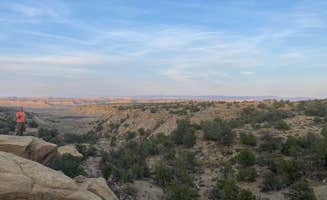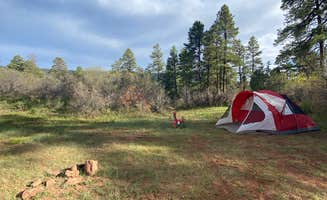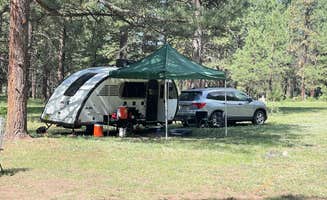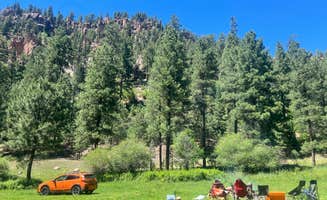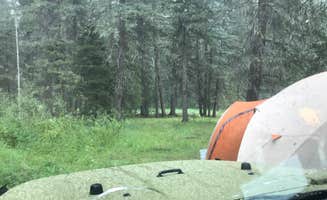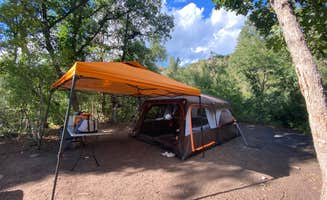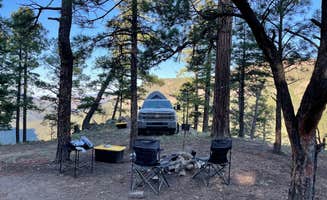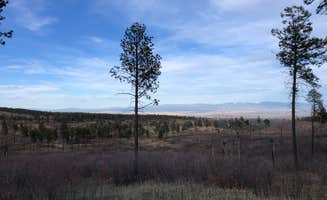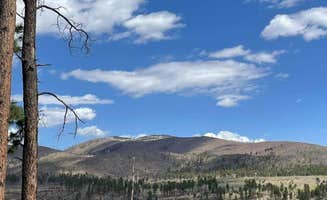Dispersed camping near Torreon, New Mexico offers campers access to multiple forest roads and public lands within the Santa Fe National Forest. Most locations sit at elevations between 7,000-8,000 feet, creating temperatures that can drop significantly at night, even during summer months. Campers typically find informal sites along forest roads 376, 378, and 533, with varying degrees of privacy and terrain.
What to do
Explore forest trails: Near Cuba Hwy Pulloff on Forest Road 88, visitors find "nice trails to walk" with "many cows wandering about in the area," according to camper Samantha L. The area combines hiking opportunities with wildlife viewing.
Visit Fenton Lake: Drive to Fenton Lake State Park from nearby dispersed sites for water activities. "I drove over to kayak after setting up camp," notes Maeci W. who stayed at Road 378 dispersed camping area. The lake provides fishing and paddling options during warmer months.
Peak bagging: The mountains surrounding dispersed campsites offer hiking challenges. At FR376 Dispersed, Josh M. reports, "There's a bit of an OHV trail leading up the mountain, halfway. From there if you want to reach a peak you do have to bushwhack a bit."
What campers like
Secluded camping spots: Many campers value the privacy available throughout the region. At Forest Road 533, Melissa J. found "about 4 pullouts off this forest road for camping, only two were occupied on Memorial Day weekend. The spot I chose was the fourth one was nice little clearing not visible from the road."
Varying terrain options: The area offers diversity in camping environments. "There are sites all along the forest road with fire pits and pretty views," notes Gabe about FR376 Dispersed. Similarly, Maya T. describes the same area offering "ones right on the river, in forrest spots or meadows, you choose!"
Ridge views: Several dispersed sites feature dramatic overlooks. Josh K. describes Road 378, Fenton Lake - Dispersed as having "the first area is a big open space with a beautiful cliff view." These elevated sites typically provide cooler temperatures and better stargazing.
What you should know
Road conditions vary significantly: Many forest roads require appropriate vehicles. "The road is a bit rough," warns Maeci W. about Road 378 access, while Melissa J. notes at Forest Road 533 that "The path into the clearing had some deep ruts, but I stayed to the side and my little Corolla did great."
Site availability fluctuates seasonally: Some areas close temporarily. Mark D. discovered this at FR376: "After a long drive I found this site to be posted and closed," recommending campers "check USFS closures" before traveling.
OHV traffic impacts quiet: Motorized recreation is popular in certain areas. "This is a very beautiful area, but boy is there a lot of traffic on this road," reports Meghan B. about Jemez Dispersed, noting noise "from OHVs, motorcycles, trucks, and music speakers" during peak weekends.
Extreme temperature swings: The high elevation creates cold nights year-round. Josh K. mentions that even "on July 4th" the Road 378 area "wasn't busy," while Maeci W. cautions the area "does get cold at night since at approximately 8,000 elevation."
Tips for camping with families
Look for established sites: For free camping near Torreon with children, seek sites with basic amenities. At Camel Head Camp, Drew T. found a "great little spot for a short night stay" that was "tucked into the ledge," making it good for quick overnight stops.
Scout clearings for multiple tents: Family groups need space. Josh K. notes Road 378 has "multiple clearing along this road. Each one is big enough for several cars and even a couple groups. The clearings are far enough apart that you can make some noise without bothering the other campers."
Pack extra layers year-round: The elevation means cold nights even in summer. "It does get cold at night since at approximately 8,000 elevation," warns Maeci W., making extra clothing essential for children camping in the Fenton Lake area.
Check fire restrictions: Rules change seasonally and vary by location. John H. describes Jemez Dispersed as "fully primitive so come prepared," noting established sites have "primitive fire rings" but restrictions often apply during summer months.
Tips from RVers
Assess size limitations: Most dispersed sites accommodate smaller rigs only. Christopher C. at Cuba Hwy Pulloff found "no amenities, but we were the only people in the area," making it suitable for self-contained camping vehicles.
Choose approach routes carefully: Some forest roads have obstacles. Cheryl W. cautions about Jemez Boondocking: "I do not recommend trying to bring a rig of any size through the Gilman tunnels. Best access for large rigs is taking 126 and accessing FS 376 from that route."
Plan for zero services: No hookups exist in dispersed areas. "Completely natural. You and the outdoors. No electricity, water connections, sewer connections, wifi, cellular, etc.," notes Christon C. about Jemez Boondocking, emphasizing the need for complete self-sufficiency.


